Principles of Marketing: Amazon's Whole Foods Acquisition Analysis
VerifiedAdded on 2020/05/03
|8
|2333
|99
Report
AI Summary
This report provides a detailed analysis of Amazon's acquisition of Whole Foods, examining the strategic implications of this major move in the grocery industry. The report begins with an executive summary and an introduction to the acquisition, highlighting its significance and the motivations behind it. A comprehensive SWOT (Strengths, Weaknesses, Opportunities, and Threats) analysis is then presented, evaluating the internal and external factors impacting the deal. The strengths include Amazon and Whole Foods' strong brand reputations, distribution networks, skilled resources, and customer loyalty. Weaknesses involve Amazon's lack of experience in physical business. Opportunities arise from sustainable growth, new environmental policies, and technological advancements. Threats include intense market competition, economic issues, and lack of offline experience. The report concludes with recommendations for Amazon, including investments in skill development, technological innovation, sales promotion, and improved customer service. The reference list provides the sources used for the analysis.
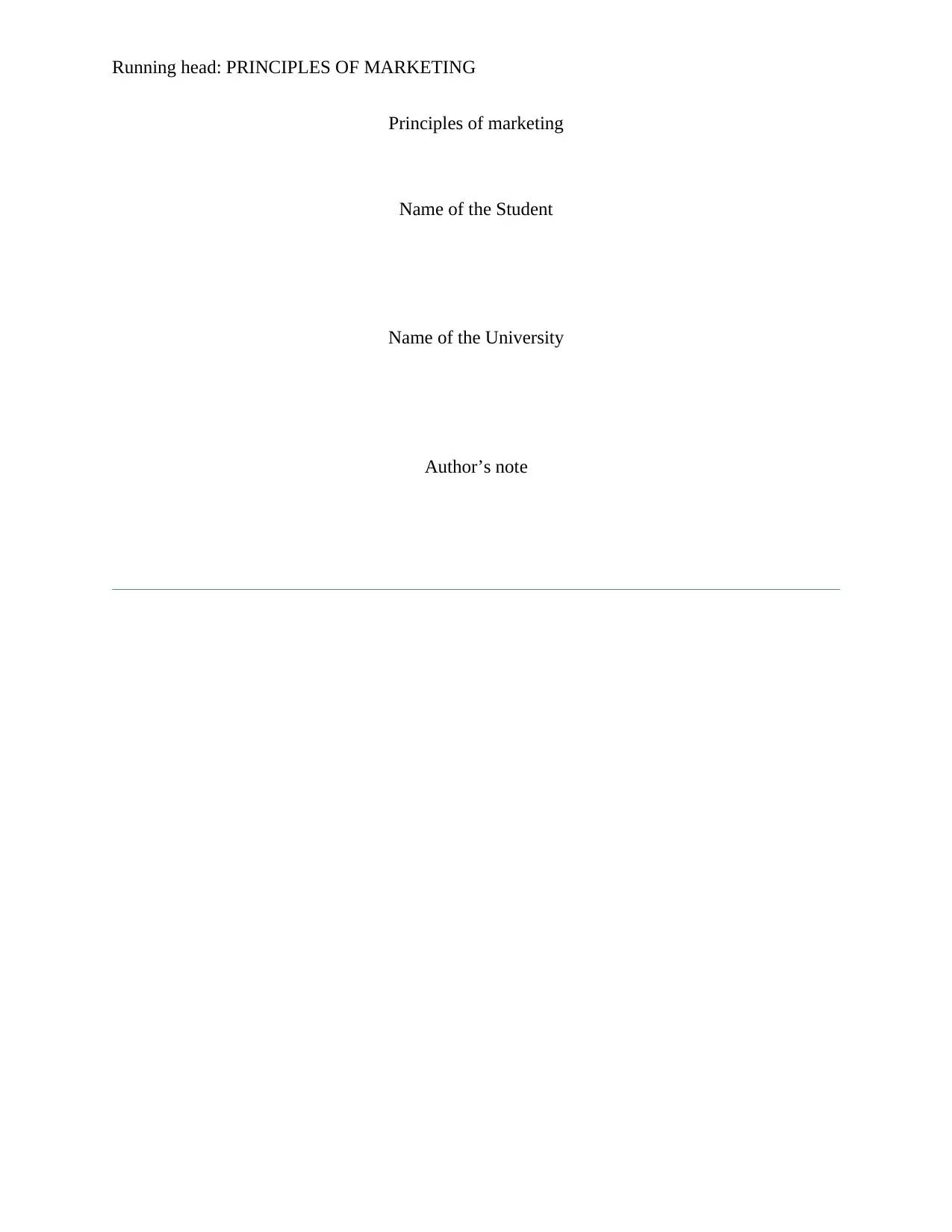
Running head: PRINCIPLES OF MARKETING
Principles of marketing
Name of the Student
Name of the University
Author’s note
Principles of marketing
Name of the Student
Name of the University
Author’s note
Paraphrase This Document
Need a fresh take? Get an instant paraphrase of this document with our AI Paraphraser
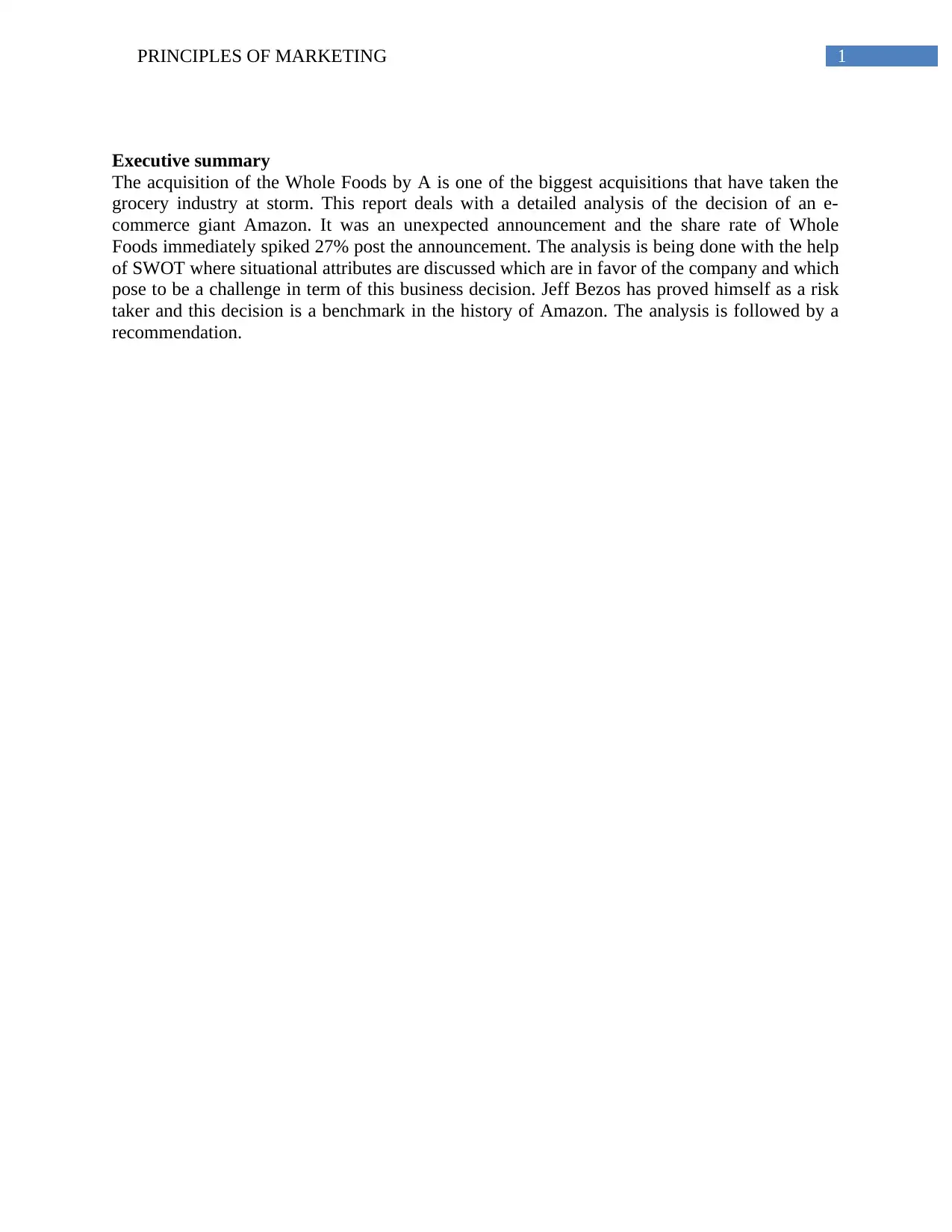
1PRINCIPLES OF MARKETING
Executive summary
The acquisition of the Whole Foods by A is one of the biggest acquisitions that have taken the
grocery industry at storm. This report deals with a detailed analysis of the decision of an e-
commerce giant Amazon. It was an unexpected announcement and the share rate of Whole
Foods immediately spiked 27% post the announcement. The analysis is being done with the help
of SWOT where situational attributes are discussed which are in favor of the company and which
pose to be a challenge in term of this business decision. Jeff Bezos has proved himself as a risk
taker and this decision is a benchmark in the history of Amazon. The analysis is followed by a
recommendation.
Executive summary
The acquisition of the Whole Foods by A is one of the biggest acquisitions that have taken the
grocery industry at storm. This report deals with a detailed analysis of the decision of an e-
commerce giant Amazon. It was an unexpected announcement and the share rate of Whole
Foods immediately spiked 27% post the announcement. The analysis is being done with the help
of SWOT where situational attributes are discussed which are in favor of the company and which
pose to be a challenge in term of this business decision. Jeff Bezos has proved himself as a risk
taker and this decision is a benchmark in the history of Amazon. The analysis is followed by a
recommendation.
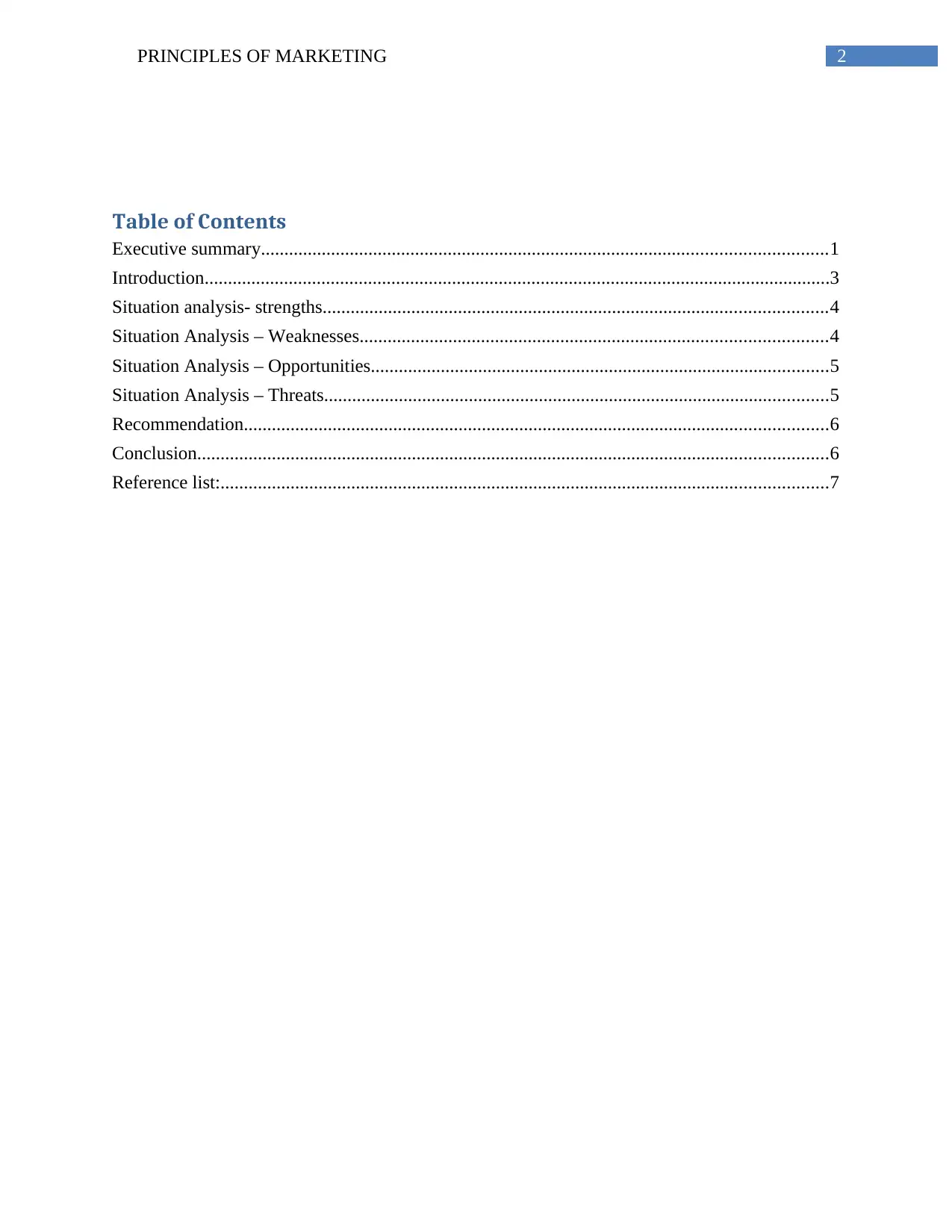
2PRINCIPLES OF MARKETING
Table of Contents
Executive summary.........................................................................................................................1
Introduction......................................................................................................................................3
Situation analysis- strengths............................................................................................................4
Situation Analysis – Weaknesses....................................................................................................4
Situation Analysis – Opportunities..................................................................................................5
Situation Analysis – Threats............................................................................................................5
Recommendation.............................................................................................................................6
Conclusion.......................................................................................................................................6
Reference list:..................................................................................................................................7
Table of Contents
Executive summary.........................................................................................................................1
Introduction......................................................................................................................................3
Situation analysis- strengths............................................................................................................4
Situation Analysis – Weaknesses....................................................................................................4
Situation Analysis – Opportunities..................................................................................................5
Situation Analysis – Threats............................................................................................................5
Recommendation.............................................................................................................................6
Conclusion.......................................................................................................................................6
Reference list:..................................................................................................................................7
⊘ This is a preview!⊘
Do you want full access?
Subscribe today to unlock all pages.

Trusted by 1+ million students worldwide
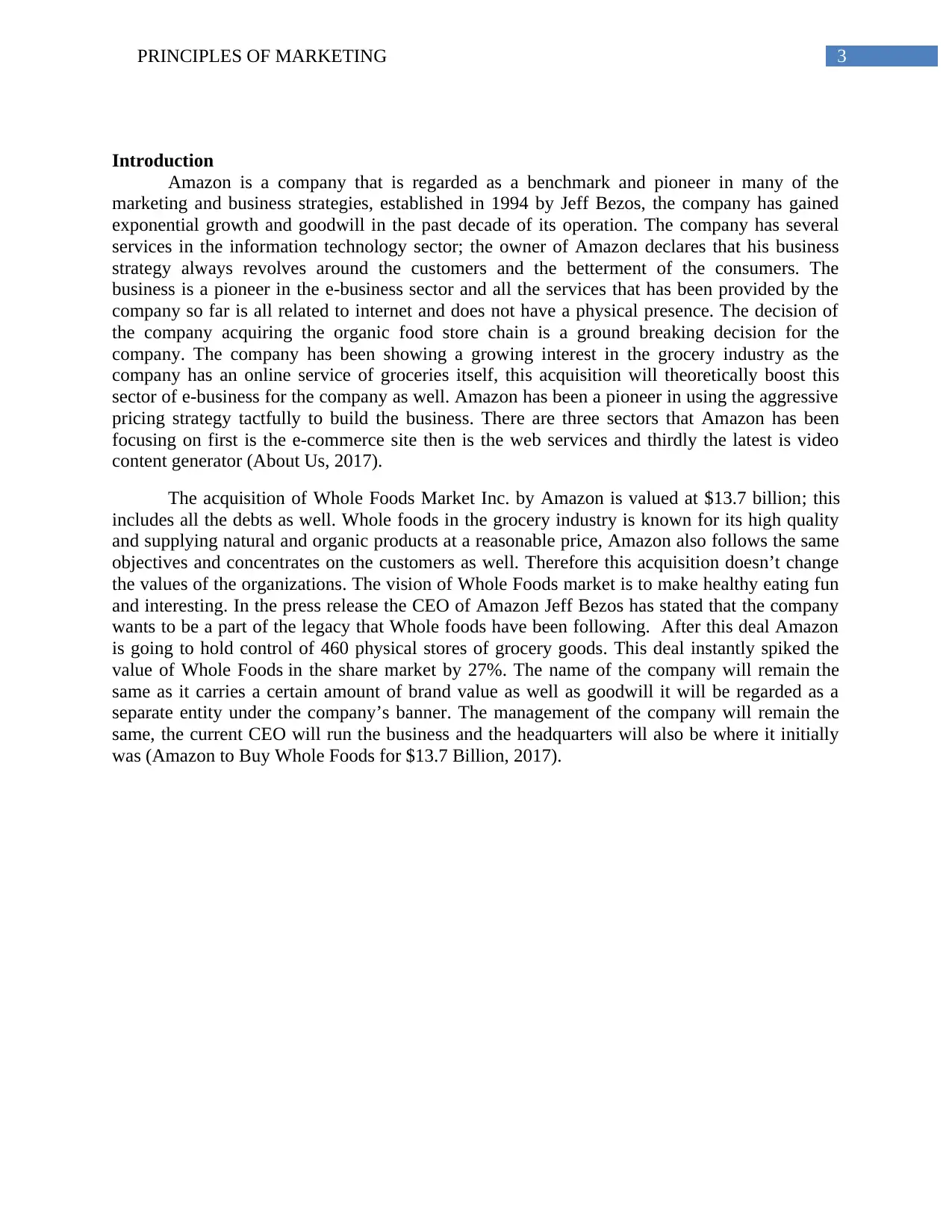
3PRINCIPLES OF MARKETING
Introduction
Amazon is a company that is regarded as a benchmark and pioneer in many of the
marketing and business strategies, established in 1994 by Jeff Bezos, the company has gained
exponential growth and goodwill in the past decade of its operation. The company has several
services in the information technology sector; the owner of Amazon declares that his business
strategy always revolves around the customers and the betterment of the consumers. The
business is a pioneer in the e-business sector and all the services that has been provided by the
company so far is all related to internet and does not have a physical presence. The decision of
the company acquiring the organic food store chain is a ground breaking decision for the
company. The company has been showing a growing interest in the grocery industry as the
company has an online service of groceries itself, this acquisition will theoretically boost this
sector of e-business for the company as well. Amazon has been a pioneer in using the aggressive
pricing strategy tactfully to build the business. There are three sectors that Amazon has been
focusing on first is the e-commerce site then is the web services and thirdly the latest is video
content generator (About Us, 2017).
The acquisition of Whole Foods Market Inc. by Amazon is valued at $13.7 billion; this
includes all the debts as well. Whole foods in the grocery industry is known for its high quality
and supplying natural and organic products at a reasonable price, Amazon also follows the same
objectives and concentrates on the customers as well. Therefore this acquisition doesn’t change
the values of the organizations. The vision of Whole Foods market is to make healthy eating fun
and interesting. In the press release the CEO of Amazon Jeff Bezos has stated that the company
wants to be a part of the legacy that Whole foods have been following. After this deal Amazon
is going to hold control of 460 physical stores of grocery goods. This deal instantly spiked the
value of Whole Foods in the share market by 27%. The name of the company will remain the
same as it carries a certain amount of brand value as well as goodwill it will be regarded as a
separate entity under the company’s banner. The management of the company will remain the
same, the current CEO will run the business and the headquarters will also be where it initially
was (Amazon to Buy Whole Foods for $13.7 Billion, 2017).
Introduction
Amazon is a company that is regarded as a benchmark and pioneer in many of the
marketing and business strategies, established in 1994 by Jeff Bezos, the company has gained
exponential growth and goodwill in the past decade of its operation. The company has several
services in the information technology sector; the owner of Amazon declares that his business
strategy always revolves around the customers and the betterment of the consumers. The
business is a pioneer in the e-business sector and all the services that has been provided by the
company so far is all related to internet and does not have a physical presence. The decision of
the company acquiring the organic food store chain is a ground breaking decision for the
company. The company has been showing a growing interest in the grocery industry as the
company has an online service of groceries itself, this acquisition will theoretically boost this
sector of e-business for the company as well. Amazon has been a pioneer in using the aggressive
pricing strategy tactfully to build the business. There are three sectors that Amazon has been
focusing on first is the e-commerce site then is the web services and thirdly the latest is video
content generator (About Us, 2017).
The acquisition of Whole Foods Market Inc. by Amazon is valued at $13.7 billion; this
includes all the debts as well. Whole foods in the grocery industry is known for its high quality
and supplying natural and organic products at a reasonable price, Amazon also follows the same
objectives and concentrates on the customers as well. Therefore this acquisition doesn’t change
the values of the organizations. The vision of Whole Foods market is to make healthy eating fun
and interesting. In the press release the CEO of Amazon Jeff Bezos has stated that the company
wants to be a part of the legacy that Whole foods have been following. After this deal Amazon
is going to hold control of 460 physical stores of grocery goods. This deal instantly spiked the
value of Whole Foods in the share market by 27%. The name of the company will remain the
same as it carries a certain amount of brand value as well as goodwill it will be regarded as a
separate entity under the company’s banner. The management of the company will remain the
same, the current CEO will run the business and the headquarters will also be where it initially
was (Amazon to Buy Whole Foods for $13.7 Billion, 2017).
Paraphrase This Document
Need a fresh take? Get an instant paraphrase of this document with our AI Paraphraser
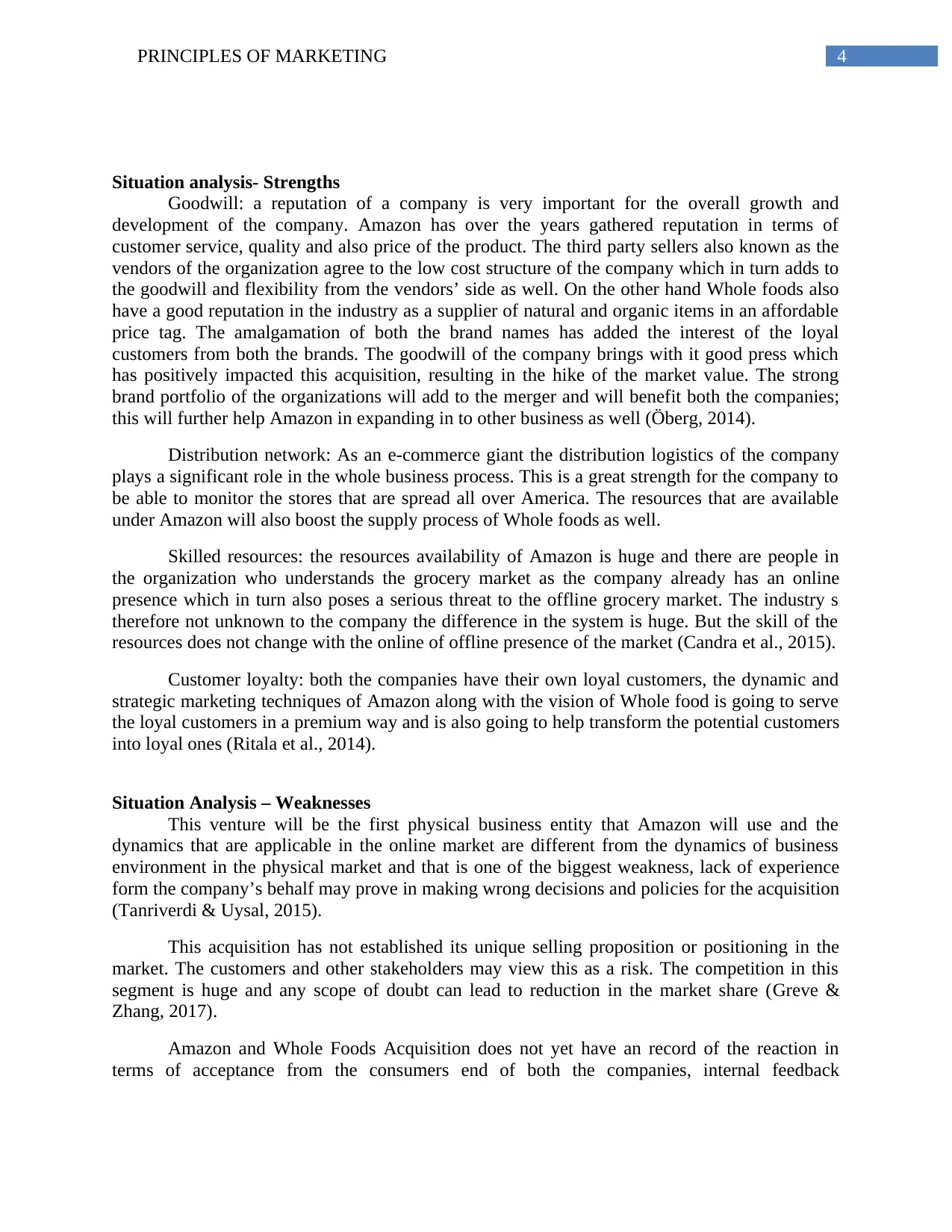
4PRINCIPLES OF MARKETING
Situation analysis- Strengths
Goodwill: a reputation of a company is very important for the overall growth and
development of the company. Amazon has over the years gathered reputation in terms of
customer service, quality and also price of the product. The third party sellers also known as the
vendors of the organization agree to the low cost structure of the company which in turn adds to
the goodwill and flexibility from the vendors’ side as well. On the other hand Whole foods also
have a good reputation in the industry as a supplier of natural and organic items in an affordable
price tag. The amalgamation of both the brand names has added the interest of the loyal
customers from both the brands. The goodwill of the company brings with it good press which
has positively impacted this acquisition, resulting in the hike of the market value. The strong
brand portfolio of the organizations will add to the merger and will benefit both the companies;
this will further help Amazon in expanding in to other business as well (Öberg, 2014).
Distribution network: As an e-commerce giant the distribution logistics of the company
plays a significant role in the whole business process. This is a great strength for the company to
be able to monitor the stores that are spread all over America. The resources that are available
under Amazon will also boost the supply process of Whole foods as well.
Skilled resources: the resources availability of Amazon is huge and there are people in
the organization who understands the grocery market as the company already has an online
presence which in turn also poses a serious threat to the offline grocery market. The industry s
therefore not unknown to the company the difference in the system is huge. But the skill of the
resources does not change with the online of offline presence of the market (Candra et al., 2015).
Customer loyalty: both the companies have their own loyal customers, the dynamic and
strategic marketing techniques of Amazon along with the vision of Whole food is going to serve
the loyal customers in a premium way and is also going to help transform the potential customers
into loyal ones (Ritala et al., 2014).
Situation Analysis – Weaknesses
This venture will be the first physical business entity that Amazon will use and the
dynamics that are applicable in the online market are different from the dynamics of business
environment in the physical market and that is one of the biggest weakness, lack of experience
form the company’s behalf may prove in making wrong decisions and policies for the acquisition
(Tanriverdi & Uysal, 2015).
This acquisition has not established its unique selling proposition or positioning in the
market. The customers and other stakeholders may view this as a risk. The competition in this
segment is huge and any scope of doubt can lead to reduction in the market share (Greve &
Zhang, 2017).
Amazon and Whole Foods Acquisition does not yet have an record of the reaction in
terms of acceptance from the consumers end of both the companies, internal feedback
Situation analysis- Strengths
Goodwill: a reputation of a company is very important for the overall growth and
development of the company. Amazon has over the years gathered reputation in terms of
customer service, quality and also price of the product. The third party sellers also known as the
vendors of the organization agree to the low cost structure of the company which in turn adds to
the goodwill and flexibility from the vendors’ side as well. On the other hand Whole foods also
have a good reputation in the industry as a supplier of natural and organic items in an affordable
price tag. The amalgamation of both the brand names has added the interest of the loyal
customers from both the brands. The goodwill of the company brings with it good press which
has positively impacted this acquisition, resulting in the hike of the market value. The strong
brand portfolio of the organizations will add to the merger and will benefit both the companies;
this will further help Amazon in expanding in to other business as well (Öberg, 2014).
Distribution network: As an e-commerce giant the distribution logistics of the company
plays a significant role in the whole business process. This is a great strength for the company to
be able to monitor the stores that are spread all over America. The resources that are available
under Amazon will also boost the supply process of Whole foods as well.
Skilled resources: the resources availability of Amazon is huge and there are people in
the organization who understands the grocery market as the company already has an online
presence which in turn also poses a serious threat to the offline grocery market. The industry s
therefore not unknown to the company the difference in the system is huge. But the skill of the
resources does not change with the online of offline presence of the market (Candra et al., 2015).
Customer loyalty: both the companies have their own loyal customers, the dynamic and
strategic marketing techniques of Amazon along with the vision of Whole food is going to serve
the loyal customers in a premium way and is also going to help transform the potential customers
into loyal ones (Ritala et al., 2014).
Situation Analysis – Weaknesses
This venture will be the first physical business entity that Amazon will use and the
dynamics that are applicable in the online market are different from the dynamics of business
environment in the physical market and that is one of the biggest weakness, lack of experience
form the company’s behalf may prove in making wrong decisions and policies for the acquisition
(Tanriverdi & Uysal, 2015).
This acquisition has not established its unique selling proposition or positioning in the
market. The customers and other stakeholders may view this as a risk. The competition in this
segment is huge and any scope of doubt can lead to reduction in the market share (Greve &
Zhang, 2017).
Amazon and Whole Foods Acquisition does not yet have an record of the reaction in
terms of acceptance from the consumers end of both the companies, internal feedback
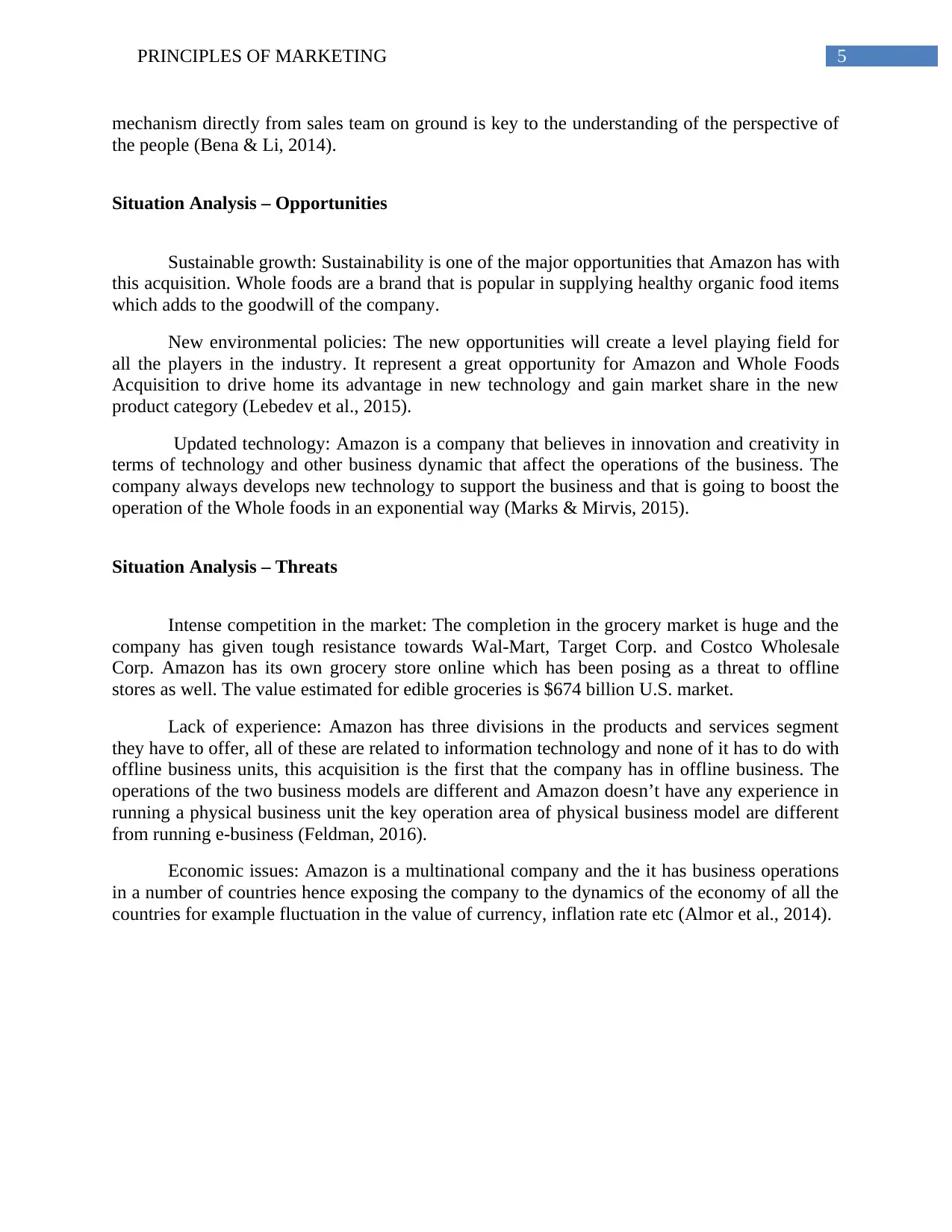
5PRINCIPLES OF MARKETING
mechanism directly from sales team on ground is key to the understanding of the perspective of
the people (Bena & Li, 2014).
Situation Analysis – Opportunities
Sustainable growth: Sustainability is one of the major opportunities that Amazon has with
this acquisition. Whole foods are a brand that is popular in supplying healthy organic food items
which adds to the goodwill of the company.
New environmental policies: The new opportunities will create a level playing field for
all the players in the industry. It represent a great opportunity for Amazon and Whole Foods
Acquisition to drive home its advantage in new technology and gain market share in the new
product category (Lebedev et al., 2015).
Updated technology: Amazon is a company that believes in innovation and creativity in
terms of technology and other business dynamic that affect the operations of the business. The
company always develops new technology to support the business and that is going to boost the
operation of the Whole foods in an exponential way (Marks & Mirvis, 2015).
Situation Analysis – Threats
Intense competition in the market: The completion in the grocery market is huge and the
company has given tough resistance towards Wal-Mart, Target Corp. and Costco Wholesale
Corp. Amazon has its own grocery store online which has been posing as a threat to offline
stores as well. The value estimated for edible groceries is $674 billion U.S. market.
Lack of experience: Amazon has three divisions in the products and services segment
they have to offer, all of these are related to information technology and none of it has to do with
offline business units, this acquisition is the first that the company has in offline business. The
operations of the two business models are different and Amazon doesn’t have any experience in
running a physical business unit the key operation area of physical business model are different
from running e-business (Feldman, 2016).
Economic issues: Amazon is a multinational company and the it has business operations
in a number of countries hence exposing the company to the dynamics of the economy of all the
countries for example fluctuation in the value of currency, inflation rate etc (Almor et al., 2014).
mechanism directly from sales team on ground is key to the understanding of the perspective of
the people (Bena & Li, 2014).
Situation Analysis – Opportunities
Sustainable growth: Sustainability is one of the major opportunities that Amazon has with
this acquisition. Whole foods are a brand that is popular in supplying healthy organic food items
which adds to the goodwill of the company.
New environmental policies: The new opportunities will create a level playing field for
all the players in the industry. It represent a great opportunity for Amazon and Whole Foods
Acquisition to drive home its advantage in new technology and gain market share in the new
product category (Lebedev et al., 2015).
Updated technology: Amazon is a company that believes in innovation and creativity in
terms of technology and other business dynamic that affect the operations of the business. The
company always develops new technology to support the business and that is going to boost the
operation of the Whole foods in an exponential way (Marks & Mirvis, 2015).
Situation Analysis – Threats
Intense competition in the market: The completion in the grocery market is huge and the
company has given tough resistance towards Wal-Mart, Target Corp. and Costco Wholesale
Corp. Amazon has its own grocery store online which has been posing as a threat to offline
stores as well. The value estimated for edible groceries is $674 billion U.S. market.
Lack of experience: Amazon has three divisions in the products and services segment
they have to offer, all of these are related to information technology and none of it has to do with
offline business units, this acquisition is the first that the company has in offline business. The
operations of the two business models are different and Amazon doesn’t have any experience in
running a physical business unit the key operation area of physical business model are different
from running e-business (Feldman, 2016).
Economic issues: Amazon is a multinational company and the it has business operations
in a number of countries hence exposing the company to the dynamics of the economy of all the
countries for example fluctuation in the value of currency, inflation rate etc (Almor et al., 2014).
⊘ This is a preview!⊘
Do you want full access?
Subscribe today to unlock all pages.

Trusted by 1+ million students worldwide
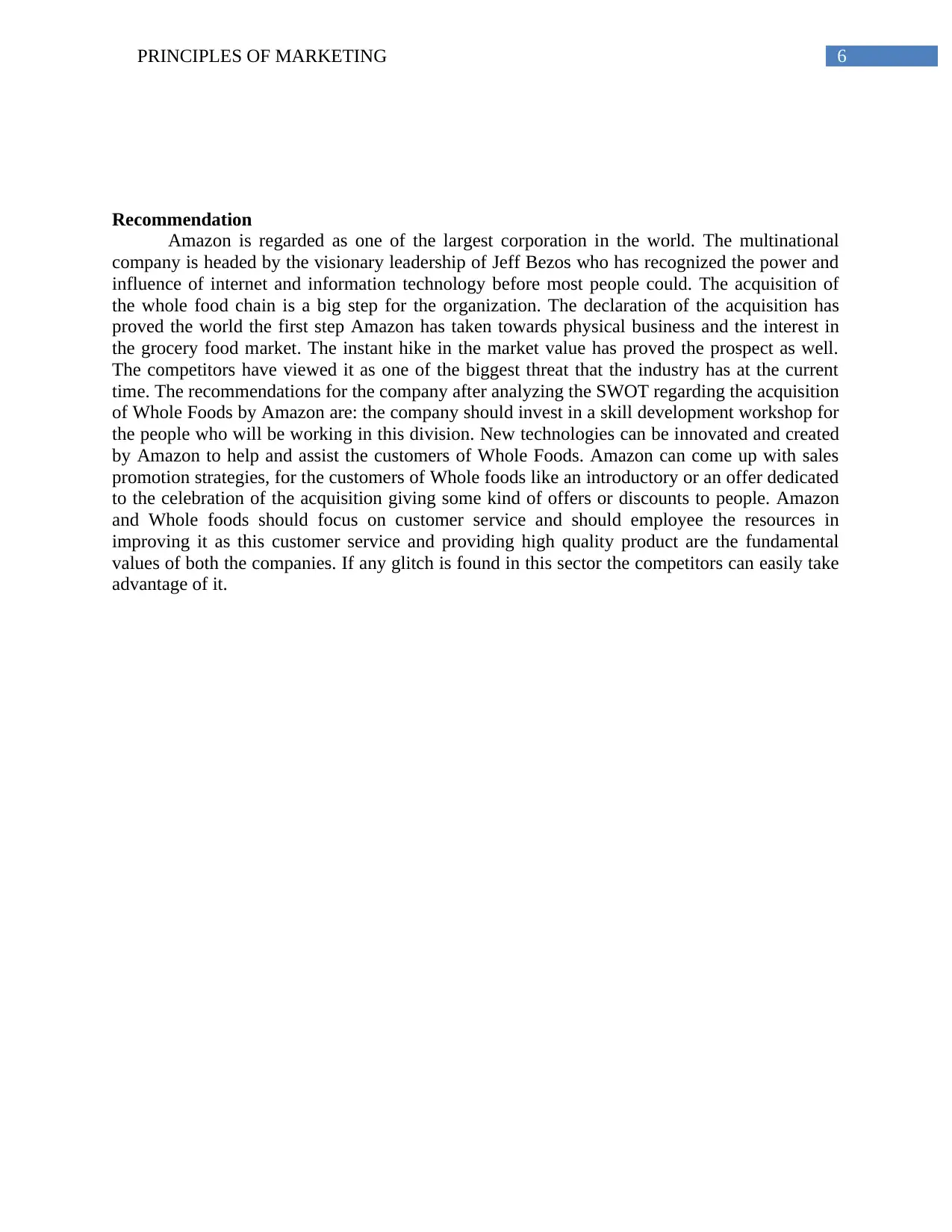
6PRINCIPLES OF MARKETING
Recommendation
Amazon is regarded as one of the largest corporation in the world. The multinational
company is headed by the visionary leadership of Jeff Bezos who has recognized the power and
influence of internet and information technology before most people could. The acquisition of
the whole food chain is a big step for the organization. The declaration of the acquisition has
proved the world the first step Amazon has taken towards physical business and the interest in
the grocery food market. The instant hike in the market value has proved the prospect as well.
The competitors have viewed it as one of the biggest threat that the industry has at the current
time. The recommendations for the company after analyzing the SWOT regarding the acquisition
of Whole Foods by Amazon are: the company should invest in a skill development workshop for
the people who will be working in this division. New technologies can be innovated and created
by Amazon to help and assist the customers of Whole Foods. Amazon can come up with sales
promotion strategies, for the customers of Whole foods like an introductory or an offer dedicated
to the celebration of the acquisition giving some kind of offers or discounts to people. Amazon
and Whole foods should focus on customer service and should employee the resources in
improving it as this customer service and providing high quality product are the fundamental
values of both the companies. If any glitch is found in this sector the competitors can easily take
advantage of it.
Recommendation
Amazon is regarded as one of the largest corporation in the world. The multinational
company is headed by the visionary leadership of Jeff Bezos who has recognized the power and
influence of internet and information technology before most people could. The acquisition of
the whole food chain is a big step for the organization. The declaration of the acquisition has
proved the world the first step Amazon has taken towards physical business and the interest in
the grocery food market. The instant hike in the market value has proved the prospect as well.
The competitors have viewed it as one of the biggest threat that the industry has at the current
time. The recommendations for the company after analyzing the SWOT regarding the acquisition
of Whole Foods by Amazon are: the company should invest in a skill development workshop for
the people who will be working in this division. New technologies can be innovated and created
by Amazon to help and assist the customers of Whole Foods. Amazon can come up with sales
promotion strategies, for the customers of Whole foods like an introductory or an offer dedicated
to the celebration of the acquisition giving some kind of offers or discounts to people. Amazon
and Whole foods should focus on customer service and should employee the resources in
improving it as this customer service and providing high quality product are the fundamental
values of both the companies. If any glitch is found in this sector the competitors can easily take
advantage of it.
Paraphrase This Document
Need a fresh take? Get an instant paraphrase of this document with our AI Paraphraser
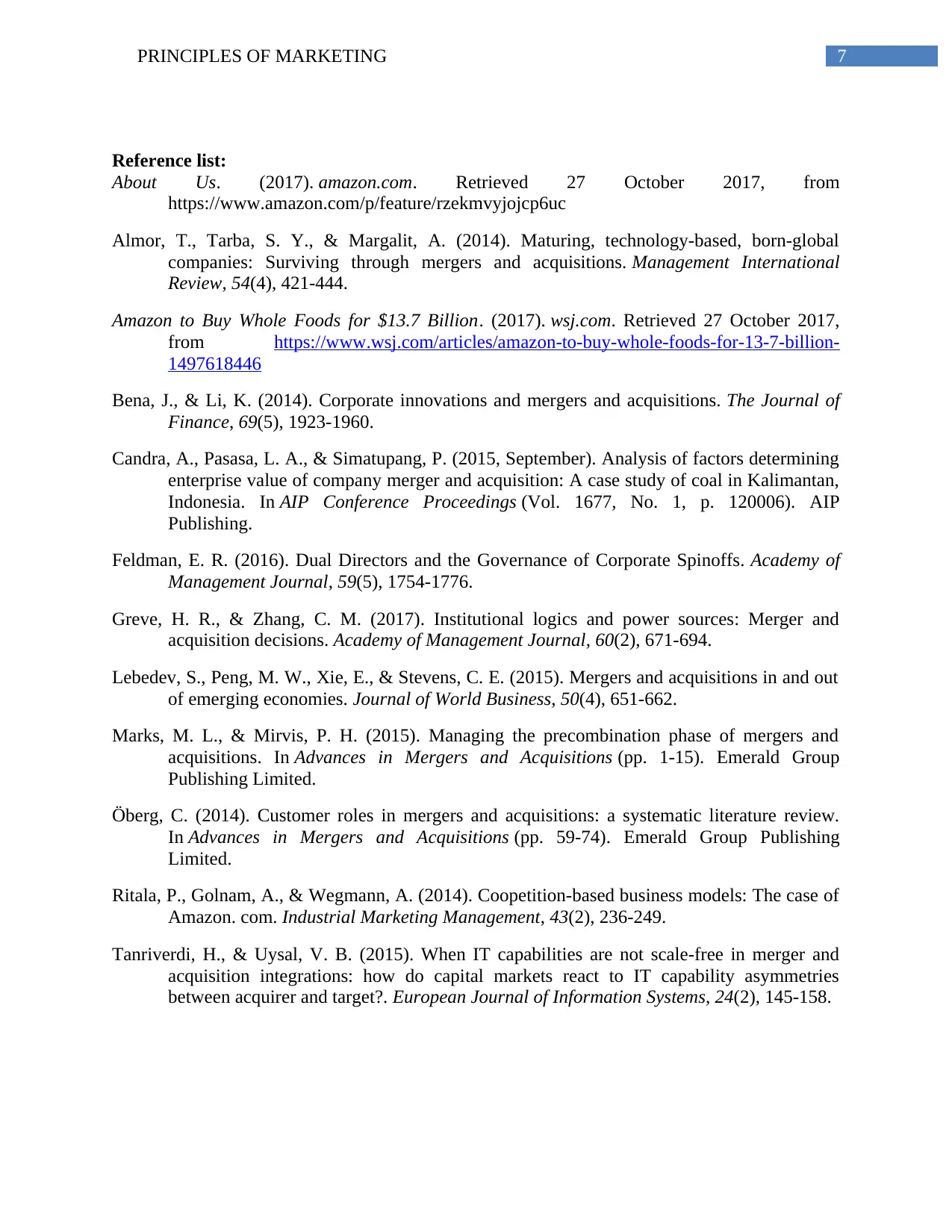
7PRINCIPLES OF MARKETING
Reference list:
About Us. (2017). amazon.com. Retrieved 27 October 2017, from
https://www.amazon.com/p/feature/rzekmvyjojcp6uc
Almor, T., Tarba, S. Y., & Margalit, A. (2014). Maturing, technology-based, born-global
companies: Surviving through mergers and acquisitions. Management International
Review, 54(4), 421-444.
Amazon to Buy Whole Foods for $13.7 Billion. (2017). wsj.com. Retrieved 27 October 2017,
from https://www.wsj.com/articles/amazon-to-buy-whole-foods-for-13-7-billion-
1497618446
Bena, J., & Li, K. (2014). Corporate innovations and mergers and acquisitions. The Journal of
Finance, 69(5), 1923-1960.
Candra, A., Pasasa, L. A., & Simatupang, P. (2015, September). Analysis of factors determining
enterprise value of company merger and acquisition: A case study of coal in Kalimantan,
Indonesia. In AIP Conference Proceedings (Vol. 1677, No. 1, p. 120006). AIP
Publishing.
Feldman, E. R. (2016). Dual Directors and the Governance of Corporate Spinoffs. Academy of
Management Journal, 59(5), 1754-1776.
Greve, H. R., & Zhang, C. M. (2017). Institutional logics and power sources: Merger and
acquisition decisions. Academy of Management Journal, 60(2), 671-694.
Lebedev, S., Peng, M. W., Xie, E., & Stevens, C. E. (2015). Mergers and acquisitions in and out
of emerging economies. Journal of World Business, 50(4), 651-662.
Marks, M. L., & Mirvis, P. H. (2015). Managing the precombination phase of mergers and
acquisitions. In Advances in Mergers and Acquisitions (pp. 1-15). Emerald Group
Publishing Limited.
Öberg, C. (2014). Customer roles in mergers and acquisitions: a systematic literature review.
In Advances in Mergers and Acquisitions (pp. 59-74). Emerald Group Publishing
Limited.
Ritala, P., Golnam, A., & Wegmann, A. (2014). Coopetition-based business models: The case of
Amazon. com. Industrial Marketing Management, 43(2), 236-249.
Tanriverdi, H., & Uysal, V. B. (2015). When IT capabilities are not scale-free in merger and
acquisition integrations: how do capital markets react to IT capability asymmetries
between acquirer and target?. European Journal of Information Systems, 24(2), 145-158.
Reference list:
About Us. (2017). amazon.com. Retrieved 27 October 2017, from
https://www.amazon.com/p/feature/rzekmvyjojcp6uc
Almor, T., Tarba, S. Y., & Margalit, A. (2014). Maturing, technology-based, born-global
companies: Surviving through mergers and acquisitions. Management International
Review, 54(4), 421-444.
Amazon to Buy Whole Foods for $13.7 Billion. (2017). wsj.com. Retrieved 27 October 2017,
from https://www.wsj.com/articles/amazon-to-buy-whole-foods-for-13-7-billion-
1497618446
Bena, J., & Li, K. (2014). Corporate innovations and mergers and acquisitions. The Journal of
Finance, 69(5), 1923-1960.
Candra, A., Pasasa, L. A., & Simatupang, P. (2015, September). Analysis of factors determining
enterprise value of company merger and acquisition: A case study of coal in Kalimantan,
Indonesia. In AIP Conference Proceedings (Vol. 1677, No. 1, p. 120006). AIP
Publishing.
Feldman, E. R. (2016). Dual Directors and the Governance of Corporate Spinoffs. Academy of
Management Journal, 59(5), 1754-1776.
Greve, H. R., & Zhang, C. M. (2017). Institutional logics and power sources: Merger and
acquisition decisions. Academy of Management Journal, 60(2), 671-694.
Lebedev, S., Peng, M. W., Xie, E., & Stevens, C. E. (2015). Mergers and acquisitions in and out
of emerging economies. Journal of World Business, 50(4), 651-662.
Marks, M. L., & Mirvis, P. H. (2015). Managing the precombination phase of mergers and
acquisitions. In Advances in Mergers and Acquisitions (pp. 1-15). Emerald Group
Publishing Limited.
Öberg, C. (2014). Customer roles in mergers and acquisitions: a systematic literature review.
In Advances in Mergers and Acquisitions (pp. 59-74). Emerald Group Publishing
Limited.
Ritala, P., Golnam, A., & Wegmann, A. (2014). Coopetition-based business models: The case of
Amazon. com. Industrial Marketing Management, 43(2), 236-249.
Tanriverdi, H., & Uysal, V. B. (2015). When IT capabilities are not scale-free in merger and
acquisition integrations: how do capital markets react to IT capability asymmetries
between acquirer and target?. European Journal of Information Systems, 24(2), 145-158.
1 out of 8
Related Documents
Your All-in-One AI-Powered Toolkit for Academic Success.
+13062052269
info@desklib.com
Available 24*7 on WhatsApp / Email
![[object Object]](/_next/static/media/star-bottom.7253800d.svg)
Unlock your academic potential
Copyright © 2020–2025 A2Z Services. All Rights Reserved. Developed and managed by ZUCOL.




